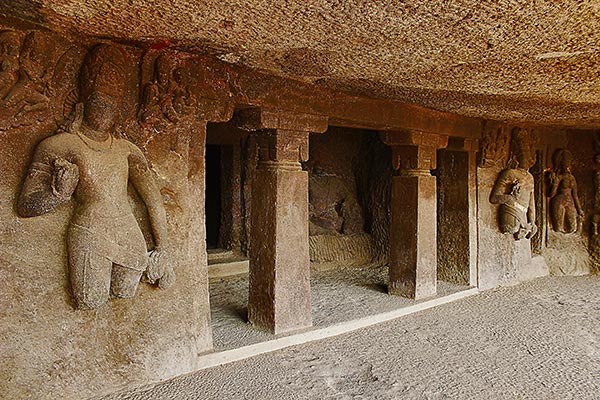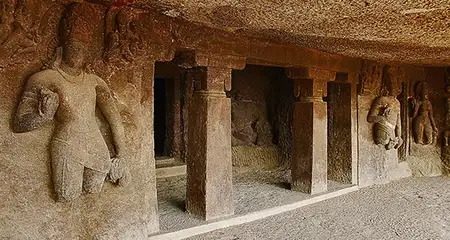Nestled in the Sihaychal Ranges near Aurangabad in the state of Maharashtra, Aurangabad Caves encompass 12 visually captivating rock-cut Buddhist caves dating back to the 6th and 7th centuries. Each of the caves are home to several remarkable carvings and sculptures of Buddhist deities belonging to the Tantra tradition. Situated around 9 km from the city, the caves offer a spectacular view of the surroundings and make for a nice outing. On your trip to Aurangabad, do squeeze in some time and pay a visit to this historical site.
Here are all the details you need to know about Aurangabad Caves, including its history, structure, timings, entry fee, cave grouping, lesser-known facts, nearby attractions, and more.
Aurangabad Caves Information
| Location | Grishneswar Temple Road, Aurangabad |
| Type | Caves |
| Timings | 9:00 am to 5:00 pm; every day |
| Entry Fee | ₹ 10 for Indians; ₹ 100 for foreigners |
| Distance from Major Transportation Hubs | Aurangabad Airport (15 km); Aurangabad Railway Station (7.5 km) |
| Photography and Videography | Allowed |
| Year of Establishment | 6th and 7th centuries |
| Architectural Style | Buddhist architecture |
| of Caves | 12 |
| Maintained by | Archaeological Survey of India |
| Material | Soft Basalt Rock |
Aurangabad Caves: History
Historical details about Aurangabad Caves are limited since, unlike other caves, they don’t contain any inscriptions. According to historians, their origin can be traced to the 6th and 7th centuries. The very first reference about this site is found at Kanheri Caves, another cluster of rock-cut caves in Maharashtra. These are one of those few caves in India where you can see the 1st millennium CE Buddhist artwork, including sculptures of Ganesha and Durga.
Aurangabad Caves: Architecture and Grouping
Aurangabad Caves are rock-cut structures carved out of soft basalt rocks. They display early Buddhist architecture and feature Buddhist shrines and residential cells called viharas.
In total, the site has 12 caves, which have been named numerically and divided into three groups. The first group includes Cave 1 to Cave 5 (Western Group) while the second group comprises Cave 6 to Cave 9 (Eastern Group). The third group includes the remaining three caves, namely Cave 10, Cave 11 and Cave 12 (Northern Group).
Cave 3 is the largest cave among all, featuring a large veranda supported by four pillars and a shrine located in the middle of the central hall. Cave 7, which is the most developed cave in the whole cluster, has a huge veranda with two cells on each side, two pilasters, and four pillars. It also features carved structures of Buddhist deities including Nandikesvara, Varaha, Ganesha, Manjusri, Avalokitesvara, and more.
Aurangabad Caves: Today
Today, Aurangabad Caves are recognized as a protected monument and maintained by the Archaeological Survey of India (ASI). Thanks to their scenic hillside setting and architectural richness, they also count among the top places to visit in Aurangabad. While the sculptures and carvings of Aurangabad Caves are remarkable in their own right, they are often eclipsed by their close proximity to the UNESCO-listed Ajanta and Ellora Caves.
Things to See in Aurangabad Caves
Aurangabad Caves attract history buffs and art connoisseurs from across the world with its ancient sculptures. Holidaymakers too often visit this site to soak in the spell-binding views. Among the major things to see at the site are:
- Cave 1: It has a veranda adorned with large Buddha sculptures and supported by eight pillars with figures of tree Goddesses and Ganas carved on the square base.
- Cave 2: The main Buddha statue of this cave is in the Pralambapadasana position, seated on a lion throne, while the hands depict the Dharmachakra Mudra.
- Cave 3: The Buddha sculpture in this cave features a preaching posture, seated on a double lotus. Striking floral designs can be seen on the doors while the arches depict Naga guardians.
- Cave 4: It is a chaitya (a sanctuary or prayer hall) shaped in a square with octagonal pillars. It is adorned with sculptures of stepped merlons, which can be seen at the Ajanta Caves as well.
- Cave 5: The Buddha image here is seen in a Padmasana position with hands in Dhyana Mudra, placed on a rectangular pedestal. Several Sarasvati Miracle figures are etched on the walls.
- Cave 6: It has a veranda supported by pillars, a porch, and cells carved on the left and right sides of the hall. Here, the Buddha is placed on a lion throne in the western style, surrounded by other figures. Two other minor shrines in this cave also have Buddhist images.
- Cave 7: Apart from the main Buddha sculpture in the central shrine, Cave 7 has two chapels and sculptures of Tara figures, Pancika, Hariti, Ganesha, Avalokitesvara, and the like.
- Cave 8: This is a small cave and you can access it through the veranda of Cave 7. It has two Buddha images depicted in the Padmasana
- Cave 9 and Cave 10: Though the structures have suffered extensive damage, the sculptures of Buddha, Padmapani, Manjusri, and Tara can be seen here.
- Cave 11 and Cave 12: These are simple halls located at the back and have no carvings but feature plain pillars.
Lesser-known Facts about Aurangabad Caves
- Aurangabad Caves have artworks that display Tantric influences.
- Historians believe that Cave 3 was carved before Cave 1.
Attractions near Aurangabad Caves
- Soneri Mahal (1.5 km)
- Bibi ka Maqbara (2.5 km)
- Panchakki (3.5 km)
- Himayat Bagh (4 km)
- Jama Masjid (4 km)
- Gul Mandi (5 km)
- Aurangabad Jain Temple (5 km)
- Chhatrapati Shivaji Museum (5 km)
- Siddharth Garden and Zoo (6 km)
- Dargah Baba Shah Musafir (6 km)
- Salim Ali Lake (6.5 km)
When it comes to size and popularity, the caves of Aurangabad might not hold a candle to the world-famous Ajanta and Ellora Caves. However, they give us some useful insights into early Buddhist architecture. Thanks to the picturesque location, they also double as a spot for family outings. So, plan your itinerary, pack your bags, and head out to explore them.

























